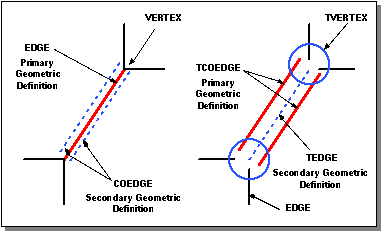|
ACIS was developed as an exact modeler, because accurate models are both robust and reliable. A model's geometry, which contains the mathematical definitions describing the intersections, agrees with the topology, which shows how model elements are connected together.
|
|
|
Tolerant modeling does not assume that geometry agrees with the topology, and takes the geometric error in the topology into consideration during modeling operations and calculations.
|
|
|
ACIS uses
SPAresabs as a tolerance value for all calculations on an exact model. Tolerant modeling assigns a tolerance value to each tolerant edge and tolerant vertex as part of the topology. This happens only when required to maintain model topology integrity.
|
|
|
For example, imagine a simple rectangular block. This has six faces, 12 edges, and 24 coedges. In an exact model, a coedge of one face references the same underlying geometric definition as a coedge of an adjacent face. There is one edge intersection for both. However, if one of the faces of the rectangular block isn't lined up properly with another adjacent face, the pair of associated adjacent coedges do not reference the same underlying geometric definition. The coedge(s) and edge do not represent the same geometric position, and the model is considered "leaky".
|
|
|
Figure 6-1 shows the difference between an exact edge and a tolerant edge. The left side of the figure illustrates the exact topology, where the
EDGE contains the primary geometric definition and the
COEDGE the secondary.
|
|

|
|
|
Figure 6-1. Exact Edges and Tolerant Edges
|
|
|
In the right side of Figure 6-1, the
TCOEDGE contains the primary geometric definition, while the
TEDGE contains the secondary.
|